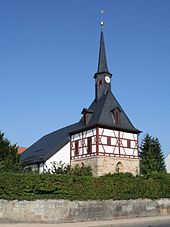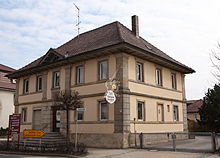Weidhausen near Coburg
| coat of arms | Germany map | |
|---|---|---|

|
Coordinates: 50 ° 12 ' N , 11 ° 8' E |
|
| Basic data | ||
| State : | Bavaria | |
| Administrative region : | Upper Franconia | |
| County : | Coburg | |
| Height : | 308 m above sea level NHN | |
| Area : | 9.61 km 2 | |
| Residents: | 3123 (Dec. 31, 2019) | |
| Population density : | 325 inhabitants per km 2 | |
| Postal code : | 96279 | |
| Area code : | 09562 | |
| License plate : | CO, NEC | |
| Community key : | 09 4 73 174 | |
| Community structure: | 3 districts | |
| Address of the municipal administration: |
Main street 2 96279 Weidhausen |
|
| Website : | ||
| Mayor : | Markus Mönch (independent) | |
| Location of the community Weidhausen near Coburg in the district of Coburg | ||
Weidhausen bei Coburg (officially: Weidhausen b.Coburg ) is a municipality in the southeast of the Upper Franconian district of Coburg .
Community structure
The community consists of the districts (former communities with their former districts):
|
history
Municipality and municipal coat of arms
Neuensorg was first mentioned in documents in 1195, Trübenbach in 1289 and Weidhausen in 1225 .
On January 1, 1971, the community Trübenbach was incorporated. Mödlitz was incorporated on January 1, 1972, but ceded to the neighboring community of Schneckenlohe in the Kronach district on May 1, 1978, with around 150 residents at that time . Before the reclassification, Neuensorg was added on January 1, 1978, which was created on February 15, 1952 from parts of Neuensee.
A manor in Weidhausen was acquired by Georg von Erffa in 1651 . The two eagle wings were taken from the coat of arms of this family in the municipal coat of arms of 1979. The colors gold and blue allude to the colors of the gentlemen von Erffa.
The municipality part of Trübenbach is represented in the coat of arms by the wavy bar for the name part -bach .
The town of Neuensorg, whose inhabitants were engaged in forest management, is symbolized by the lumberjack tools, the felling ax and the Reuthaue , which are still in use today .
The colors silver and red are reminiscent of the affiliation of the entire municipality to the Bamberg monastery .
place
Weidhausen was first mentioned in a document in 1225. The place name means the house on the pasture. It was mentioned in an exchange document in 1299, after which Weidhausen and Trübenbach were separated from the Bamberg diocese in exchange for the places Staffelstein, Loffeld and Horb and the mill in Horchelsdorf came to the Sonnefeld monastery. The places were the property of the monastery until the monastery was secularized in 1532. Then they went to the office of Sonnefeld.
Before the outbreak of the Thirty Years War , Weidhausen had around 180 residents and 40 buildings. Due to epidemics and starvation, the number fell to around 70 inhabitants by 1638, who only lived in 10 houses. In 1650 around 100 people lived in 21 buildings in the village. In 1636 less than five percent of the arable land was cultivated with winter sowing, the summer sowing was completely canceled. There was no more livestock farming between 1638 and 1642.
In 1548, Weidhausen received permission to brew brewery, and the community brewery was probably built at the end of the 16th century. It was canceled in 1883. In 1678 the place got the permission for the hostel and business fairness. In 1880 there were five breweries in the village.
After Duke Albrecht's death in 1699, Weidhausen came to Sachsen-Hildburghausen in 1705 as part of the Sonnefeld office . In 1826 the office of Sonnefeld came back to Saxony-Coburg in accordance with the Hildburghausen partition agreement .
In 1901, Weidhausen got a connection to the railway network with the first section of the Steinach Valley Railway via Ebersdorf near Coburg . In 1989 the line was closed. In a referendum on 30 November 1919 13 citizens for the accession of the approved State of Coburg the Thuringian State and 478 against. A central water supply system was built in the late 1920s.
On April 20, 1933, Adolf Hitler and Hans Schemm became honorary citizens. A memorial in the center of the village was dedicated to Schemm in 1936. A Hitler Youth Home was built in 1938.
57 soldiers were killed in the First World War; after the Second World War, 99 were killed and 47 were missing. American troops arrived on April 12, 1945.
In 1955 the first sewage treatment plant was put into operation and in 1964 a new school was inaugurated. In 1969 the community won the competition “The more beautiful village” in the Coburg district.
Village development
In 1514 Weidhausen had a three-quarter estate, fourteen half-estates, five quarter estates, four Erbsölden and seven houses with court rights. There was also a mill, a community smithy and an ancestral farm of the Sonnefeld monastery.
In 1584 there was a five-quarter estate in Weidhausen, one three-quarter estate, twelve half-estates, eight quarter estates, five Erbsölden, five houses and farms, a forge, a mill, and an ancestral farm.
In 1604 the Fünfviertelgut became a mansion. The first owners were the Buchner, a long-established Coburg bourgeois family. In 1651 the district administrator Georg Siegmund von Erffa acquired the manor. In 1699 it was bought by the chamberlain Johann Lorenz Muffel von Ermreuth. Further owners were from 1711 the lawyer Johann Philipp Eschenbach, from 1724 the city of Coburg, from 1821 the Meiningische chamber landlord Johann Jacob Schmidt. The latter began selling land to pay off debt. After at least another five owners in the 1840s and 1850s, August Ferdinand Lomatsch demolished the estate in 1861.
In 1658 there were a three-quarter estate, nine half-estates, eleven quarter estates, seven Sölden, two houses and farms, three little houses, a forge, a mill, an ancestral farm and a brewery. In 1772 the situation was very similar with a three-eighth estate, nine half-estate, twelve quarter-estate, six houses and farms, four Erbsölden, five drip houses , a forge, a mill, a brewery and an ancestral farm.
The changes were mainly due to inheritance divisions. By 1860, out of a total of 90 buildings, the number of drip houses rose to 36. In 1916 there were 215 inhabited houses and in 1939 there were 268. In 1999 there were 968 buildings.
After the end of the war, the population grew by around 650 to around 2000 people. Weidhausen changed from a farming village to an industrial village. At the end of the 20th century there were still six farms.
politics
Municipal council
The municipal council has 16 members. The 2020 local elections resulted in the following distribution of seats (compared to the 2014 election):
- CSU 4 seats (± 0)
- Free citizens 7 seats (+1)
- Village community 5 seats (−1)
mayor
The first mayor is Markus Mönch (independent), who was the only candidate in 2020 and was confirmed. After a runoff election in 2008, Mönch replaced his predecessor Werner Platsch (SPD). Splash was first elected in 1990.
coat of arms
Description : Divided by blue and red by a silver wavy bar; above an open golden flight, below, crossed at an angle, a silver felling ax and a silver hoe.
Town twinning
The community is twinned with Frankfort , Illinois ( USA ).
traffic
Weidhausen is on the B 303 , which connects Coburg with Kronach. The place had a train station on the Ebersdorf b.Coburg – Neustadt b.Coburg railway line , which has since been closed .
economy
Weidhausen was the first place in the Duchy of Saxony-Coburg where basketry was made at the beginning of the 19th century. In neighboring Michelau , the basket-making trade is documented as early as the 16th century. In 1857 there were over 100 basket-makers in Weidhausen, in 1906 there were 506 basket-makers and in 1928 900. Most of them were also active in agriculture. From the 1930s onwards, upholstery began to replace basket-making in home-based businesses. At the end of the 20th century there were no more basket makers. In the mid-1960s, the upholstered furniture industry consisted of 21 companies and employed almost 1,300 people, including around 700 from Weidhausen. In 2000 there were 10 upholstered furniture companies with around 1500 employees.
Architectural monuments
literature
- Werner Schumann: Weidhausen b. Coburg through the centuries. Schneider-Druck, Weidhausen 2000, ISBN 3-9805880-3-3 .
Web links
- Entry on the coat of arms of Weidhausen near Coburg in the database of the House of Bavarian History
- Weidhausen near Coburg: Official statistics of the LfStat (PDF; 1.7 MB)
Individual evidence
- ↑ "Data 2" sheet, Statistical Report A1200C 202041 Population of the municipalities, districts and administrative districts 1st quarter 2020 (population based on the 2011 census) ( help ).
- ↑ a b Wilhelm Volkert (Ed.): Handbook of the Bavarian offices, communities and courts 1799–1980 . CH Beck, Munich 1983, ISBN 3-406-09669-7 , p. 442 .
- ^ Federal Statistical Office (ed.): Historical municipality directory for the Federal Republic of Germany. Name, border and key number changes in municipalities, counties and administrative districts from May 27, 1970 to December 31, 1982 . W. Kohlhammer, Stuttgart / Mainz 1983, ISBN 3-17-003263-1 , p. 691 .
- ^ Federal Statistical Office (ed.): Historical municipality directory for the Federal Republic of Germany. Name, border and key number changes in municipalities, counties and administrative districts from May 27, 1970 to December 31, 1982 . W. Kohlhammer, Stuttgart / Mainz 1983, ISBN 3-17-003263-1 , p. 680 .
- ↑ a b c d Werner Schumann: Weidhausen b. Coburg through the centuries. Schneider-Druck, Weidhausen 2000, ISBN 3-9805880-3-3 , p. 12f





